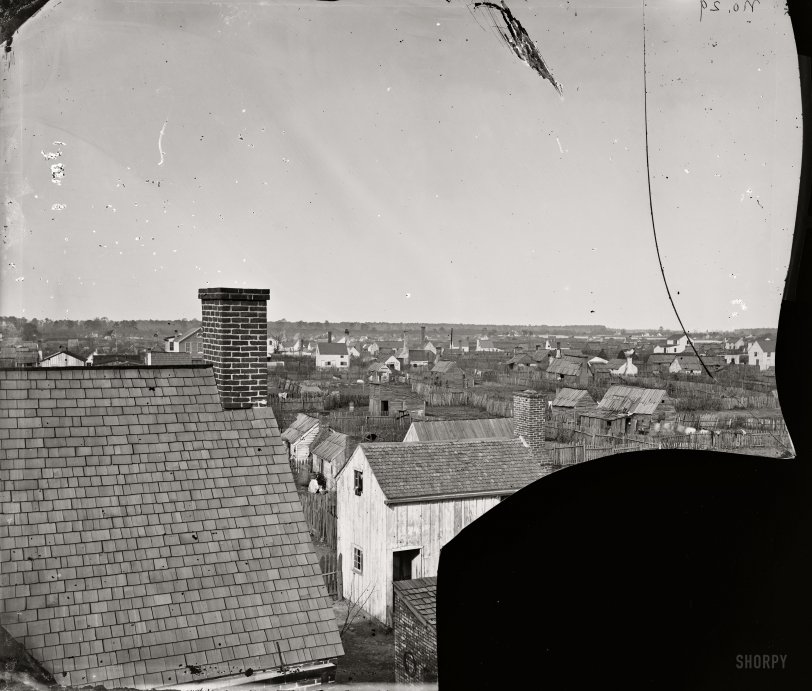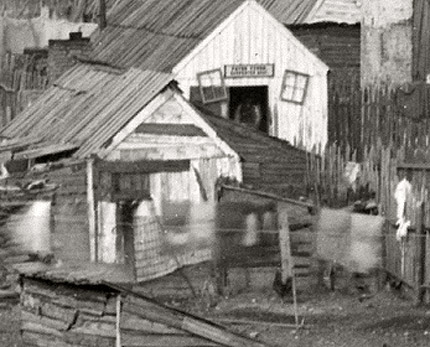


Framed or unframed, desk size to sofa size, printed by us in Arizona and Alabama since 2007. Explore now.
Shorpy is funded by you. Patreon contributors get an ad-free experience.
Learn more.

- Roll your own
- Rugged and real!
- A Charles Purcell - Mama Cass Connection
- Uncle SAAM
- Obfuscation
- One Chocolate Soldier rode away
- Victor Marquis de la Roche
- The Little House Across Way ...
- Vanderbilt Gates
- Vanderbilt Mansion
- You can still see that gate
- Withering heights for me
- So Jim,
- Top Heavy
- Re: Can't Place It.
- Bus ID
- Since you mention it
- The White Pages ?
- Moonlight Tower
- 1907?
- Fire(men) and Water
- Can't Place It
- Can anyone
- Wings
- Where's Claudette and Clark?
- Overbuilt Rolodex
- One song
- Give Me Wings Please!
- PRR
- Pinball Wizards
Printporium
Slabtown: 1864

December 1864. "Slabtown. Hampton, Virginia." One of two views of Hampton's slave refugee camps built during the Civil War. The dooryards and various blurry figures moving about in this broken glass negative afford a rare glimpse of life in the mid-19th century. Photographer unknown. View full size.
The Cummings and their window
I also wonder who had the fancy establishment with the upscale window and that sign. They must have been a business to want the name so prominently, but were they catering to these folks or those who left when their homes were destroyed with the war? The chimneys in that part of town appear to be the ones in the article that were from older buildings, while the one in the foreground looks fresh made from homemade bricks. My guess is Cummings managed to survive the war and their business may have survived as well. Otherwise, people would have taken down the sign and used it for scrap wood.
Whitewash
Some of these buildings bring to mind the expression "They're too poor to paint and too proud to whitewash."
Slabtown history
After Major General Benjamin F. Butler accepted three runaway slaves seeking their freedom under the declaration that they were "contraband of war," two contraband camps were established in Hampton to accommodate the influx of refugees. One was constructed out the entrance to Fort Monroe in Camp Hamilton and became known as Slabtown and another, the Grand Contraband, was established amid Hampton's ruins. The name Slabtown refers to the odds and ends of construction material used to build shanties adjacent to standing chimneys.
-- Hampton Visitors Bureau
Cock-a-Doodle
I think I see a rooster! Or a hen. Under the blurry laundry on the line next to a little hut or shack or whatever.

Thank you for these
Thank you for these particular set of photos; they are fascinating, like stepping into the past. It must have been a windy day as the laundry on lines is moving, but not the pair of long johns on the fence. What do you suppose the fancy establishment with the sign "S Cumming" was?
There it yet waves.
A blurry vision of the 1864 edition of the Star-Spangled Banner, just below the line of the horizon at the far left-hand side of the photograph.
Path View
The concept of a street or a lane seems lost here; more like a maze of houses, yards, gardens. I'd like to see GPS handle this! "Open fence. Close fence, to keep in chickens. Go past shed. Cross the garden."
























On Shorpy:
Today’s Top 5